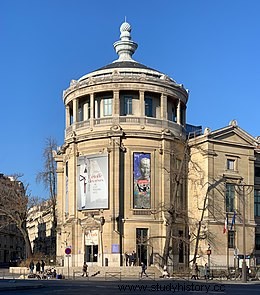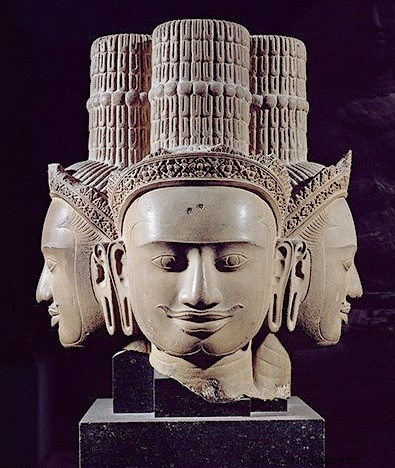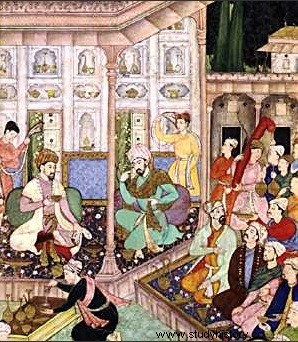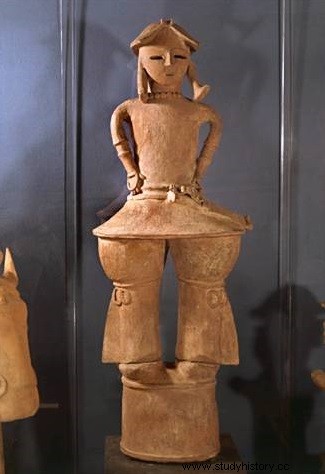 The Guimet Museum is the national museum of Asian Arts, devoted to the arts of the civilizations of the East and the Far East. Since 1945, it has also been the Asian department of the National Museums. Founded in Lyon in 1879 by the orientalizing industrialist Émile Guimet to promote oriental religions and civilisations, it was transferred to Paris when its collections were ceded to the State in 1885. Both a museum and a research and study centre, it is in constant contact with missions on the spot, has a vast specialized library and regularly publishes the review of Asian Arts. It is the headquarters of societies bringing together amateurs and specialists such as the Association of Friends of Angkor. A major renovation program has been undertaken since 1996.
The Guimet Museum is the national museum of Asian Arts, devoted to the arts of the civilizations of the East and the Far East. Since 1945, it has also been the Asian department of the National Museums. Founded in Lyon in 1879 by the orientalizing industrialist Émile Guimet to promote oriental religions and civilisations, it was transferred to Paris when its collections were ceded to the State in 1885. Both a museum and a research and study centre, it is in constant contact with missions on the spot, has a vast specialized library and regularly publishes the review of Asian Arts. It is the headquarters of societies bringing together amateurs and specialists such as the Association of Friends of Angkor. A major renovation program has been undertaken since 1996.
The Guimet Museum, from its foundation in Lyon to its transfer to Paris
Founded in Lyon in 1879 by the Orientalizing industrialist Émile Guimet (1836-1918) in order to promote the religions and civilizations of the Orient, the museum was transferred to Paris after 'Émile Guimet bequeathed his collections to the State in 1885 and had a building built at the corner of rue Boissière and avenue d'Iéna (in the 16th arrondissement) to accommodate them. Designed by the architect Charles Terrier, the museum was inaugurated in 1889 in the presence of the President of the Republic, Sadi Carnot. It was attached to the Directorate of French Museums in 1927, the year from which the transfer to the Guimet Museum of works from the Museum of Indochinese Ethnography of Trocadéro was undertaken - until 1931.
 Became a national museum in 1928, the Guimet museum is enriched by pieces brought back from Asia by the various French missions , in particular those of Édouard Chavannes in Shaanxi, Paul Pelliot in Chinese Turkestan and Gansu, or even Joseph Hackin in Afghanistan. After the addition in 1945 of the collections of the Asian arts department of the Louvre museum in exchange for Greco-Roman and Egyptian pieces from the Guimet collection, the Guimet museum is now exclusively dedicated to oriental arts and officially takes the name of "Musée national of Asian Arts-Guimet”.
Became a national museum in 1928, the Guimet museum is enriched by pieces brought back from Asia by the various French missions , in particular those of Édouard Chavannes in Shaanxi, Paul Pelliot in Chinese Turkestan and Gansu, or even Joseph Hackin in Afghanistan. After the addition in 1945 of the collections of the Asian arts department of the Louvre museum in exchange for Greco-Roman and Egyptian pieces from the Guimet collection, the Guimet museum is now exclusively dedicated to oriental arts and officially takes the name of "Musée national of Asian Arts-Guimet”.
The 1996 restructuring
In 1996, under the aegis of the French Museums Department, a museum renovation program was launched and entrusted to French architects Henri and Bruno Gaudin. Completely overhauled after four years of titanic work, the museum was reopened to the public in January 2001. The collections (some 3,500 exhibits, out of the 45,000 in total held by the museum) are arranged on five levels in a didactic and reasoned way , according to a geographical route and a chronological order.
From the reception, near a monumental double branch staircase which constitutes the backbone of the building, the visitor faces a giant naga (temple guardian). Composed of thirty-one blocks of sandstone and weighing thirteen tons, it is the reassembly of the old south balustrade (Giant's Causeway) of the east aisle of the Preah Khan of Angkor. Dismantled in 1873-1874 by the discoverer of the site, Lieutenant Louis Delaporte, this piece had never been exhibited since its exhibition at the Trocadero Palace, as part of the Universal Exhibition of 1878.
A museum dedicated to Asian arts
Access to the Southeast Asian collections (of which the museum holds around 4,700 pieces), installed on the ground floor, is via the around the large glass roof dedicated to Khmer statuary, where in the background stands a pediment of the sanctuary of Banteay Srei (circa 967), donated in 1936 by the French School of the Far East (ÉFEO). Articulated around the collection of Khmer art and Champa (the heart of the museum and the largest museographic ensemble of Khmer art in the world, after that of the National Museum of Phnom Penh) "is put in perspective" (Henri Gaudin) a whole panorama pieces from various schools of Thai art (Sukhothaï, Ayuthya, etc.), Laotian pieces, post-Pagan Burmese works, ceramics and archaic bronzes from Vietnam, terracotta, bronzes, stone statues volcano of Java or Sumatra.
 India is represented by very beautiful testimonies of the Indus civilizations, of the school of Mathura (pink sandstone statue of the Serpent-King Nagaraja, 2nd century), Amaravati school (slabs covering stupas), Gupta period (bas-reliefs), Chola period (bronze statue of Shiva Nataraja, "Lord of the dance") and of the Dekkan school; the textiles, silverware and jewelery from Mughal India from the Jean and Krishnâ Riboud donation are presented on the first floor, in the graphic arts rotunda, in the entrance hall of the old paneled library of Napoleon III style (where, in 1905, during the lifetime of Émile Guimet, Mrs Campbell Mac Leod, the future Mata Hari, performed a few “Brahmanic dances” before the Tout-Paris).
India is represented by very beautiful testimonies of the Indus civilizations, of the school of Mathura (pink sandstone statue of the Serpent-King Nagaraja, 2nd century), Amaravati school (slabs covering stupas), Gupta period (bas-reliefs), Chola period (bronze statue of Shiva Nataraja, "Lord of the dance") and of the Dekkan school; the textiles, silverware and jewelery from Mughal India from the Jean and Krishnâ Riboud donation are presented on the first floor, in the graphic arts rotunda, in the entrance hall of the old paneled library of Napoleon III style (where, in 1905, during the lifetime of Émile Guimet, Mrs Campbell Mac Leod, the future Mata Hari, performed a few “Brahmanic dances” before the Tout-Paris).
The Tibetan, Chinese and Japanese collections
The first floor section brings together an exceptional collection of gouache paintings, tankas and Nepalese and Tibetan bronzes, funds enriched in 1989 thanks to the donation by Lionel Fournier of his collection of Himalayan art. Also exhibited on this floor are Gandhara works (from some one hundred pieces in the Alfred-Foucher collection from the Louvre), Indian ivories, Greco-Roman blown glass and Chinese lacquerware from the Begram treasure (discovered in 1937 in Afghanistan by Ria and Joseph Hackin, director of the museum from 1923 to 1941), as well as part of the museum's Chinese collections, from the Neolithic period to the Ming dynasty:Yangshao jars; archaic bronzes and Shang and Zhou jade; Han terracotta (Sichuan horses and court ladies); evocation of the Silk Road under the Tang dynasty in a room dedicated to the donation made in 1995 by the Belgian collector Jacques Polain), Wei, Song, Yuan and Ming statuary.
 As for the arts of Buddhist Central Asia (also called Serindia) of the Tarim Basin, they are notably represented by works brought back by the French mission (1906-1909) by Paul Pelliot:dried lands of Tumshuq (Serindian Buddhist complex in Xinjiang) and above all a prestigious set of sculptures (including lokapala:guardian gods) and paintings on silk ( "The Assault of Mara") of the Mogao Caves of Dunhuang (more particularly of the famous "niche of manuscripts" discovered in 1900 by the Taoist monk Wang), paintings exhibited by rotation because of their fragility.
As for the arts of Buddhist Central Asia (also called Serindia) of the Tarim Basin, they are notably represented by works brought back by the French mission (1906-1909) by Paul Pelliot:dried lands of Tumshuq (Serindian Buddhist complex in Xinjiang) and above all a prestigious set of sculptures (including lokapala:guardian gods) and paintings on silk ( "The Assault of Mara") of the Mogao Caves of Dunhuang (more particularly of the famous "niche of manuscripts" discovered in 1900 by the Taoist monk Wang), paintings exhibited by rotation because of their fragility.
The second floor houses the art of Japan — a collection of clay pottery from the Jomon period and the Yayoi period, paintings and statues from the Nara period (710 -794), graphic arts from the Edo period (1603-1868) — as well as the most important collection of Korean art outside the Asian continent (Charles Varat collection), including celadons from the Koryo period (918- 1392). On this floor and on the upper floor (third floor) is again represented the Middle Kingdom with Chinese Buddhist paintings and a very fine collection of Song, Yuan, Ming and Qing ceramics (presented in study cases) . The top of the rotunda (“rotonde aux lacquers”), on the fourth floor, presents a fine set of Chinese screens from the 17th and 18th centuries.
An annex to the Musée Guimet, installed since 1968 in the former private mansion of Alfred Heidelbach, houses pieces illustrating the Japanese Buddhist Pantheon, brought together by Émile Guimet in 1876, as well than thirty-three masterpieces (paintings and sculptures) of Buddhist China. At the heart of the galleries is also a Japanese garden.
The Guimet Museum, research and study center
At the same time a museum, a research and study center and a photographic archive, the Guimet Museum is in constant contact with archaeologists and researchers; he regularly publishes the review Asian Arts. It is the headquarters of associations bringing together amateurs and specialists such as the French Asian Society (association for the promotion of Asian arts) or the Association of Friends of Angkor. Several rooms are dedicated to temporary exhibitions, on the ground floor (where the museum's reserves and an auditorium have also been set up) and on the ground floor, an upper floor where a specialized library is also installed.
Access to the Guimet Museum
National Museum of Asian Arts Guimet
6, place d'Iéna
75016 Paris
Information on 01 56 52 53 00
Opening hours
Every day except Tuesday, from 10 a.m. to 6 p.m.
The cash desk closes at 5:15 p.m.
Rooms close at 5:45 p.m.
To go further
- National Museum of Asian Arts, Guimet Museum (Paris). 2001.
- The Guimet Museum website.
